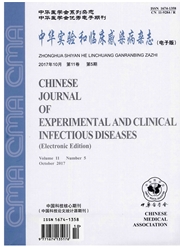

 中文摘要:
中文摘要:
目的:建立HBV抗原特异性细胞毒性T细胞(CTLs)介导的小鼠肝炎模型,探讨肿瘤诱导的髓源抑制性细胞(MDSCs)在免疫介导的HBV转基因小鼠肝损伤中的有效性。方法制备新鲜的HBV转基因小鼠肝脏匀浆,予普通小鼠腹腔注射,1次/周,连续4周,以诱导致敏小鼠(Sensitized-mice)产生HBV抗原特异性CTLs(HBV-specific CTLs,HBV-CTLs)。分离致敏小鼠脾脏来源HBV-CTLs,静脉回输给高复制型HBV转基因小鼠,分别在注射前,注射后1 d、3 d、6 d和9 d经眶后取血测血清ALT/AST水平。分离荷瘤小鼠骨髓来源的MDSCs,静脉注射给HBV-CTLs诱导的肝炎小鼠,并在注射后24 h,经眶后取血测血清ALT/AST水平,肝脏组织经固定、石蜡包埋、HE染色进行组织形态学检测。结果致敏小鼠脾脏来源的HBV-CTLs可诱导HBV转基因小鼠肝组织损伤,血清ALT、AST水平呈升高趋势;且与CTLs注射组小鼠相比,CTLs联合MDSCs注射组小鼠肝脏组织损伤程度减轻,小鼠血清转氨酶水平显著降低[ALT:(254.5±25.50)vs (80.67±11.57),P <0.05;AST:(301.5±40.50)vs(249.0±79.00),P >0.05)]。结论静脉回输肿瘤诱导的MDSCs可有效减轻HBV-CTLs诱导的肝炎小鼠中肝组织损伤。
 英文摘要:
英文摘要:
Objectives To establish murine hepatitis model in HBV transgenic mice and to investigate the role of Gr-1+CD11b+ myeloid-derived suppressor cells (MDSCs) in attenuating liver injury in immune-mediated murine hepatitis model. Methods Repetitive intraperitoneal injection of liver homogenate from HBV transgenic mice into na?ve BALB/c mice (recipient mice) was performed at once a for four weeks. HBV-specific CTLs (HBV-CTLs) were from spleen of recipient mice. Tumor-induced MDSCs were isolated from bone marrow of tumor-bearers and purified by magnetic system. HBV transgenic mice were treated with HBV-CTLs injection (1 × 107/per mouse, i.v.) or co-injection of HBV-CTLs (1 × 107/per mouse, i.v.) and MDSCs (5 × 106/per mouse, i.v.). Serum ALT/AST levels were detected before and 24 hours after cells transfer to evaluate the liver injury. Paraffin-embedded liver tissue was sectioned for HE staining. Results HBV-CTLs injection caused acute liver injury in HBV transgenic mice were observed, characterized by acute increase of serum ALT and/or AST levels. Co-injection of CTLs and MDSCs could effectively attenuate liver injury in hepatitis mouse model (ALT: 254.5 ± 25.50 vs 80.67 ± 11.57, P 0.05). Morphological analysis showed alleviation of liver injury in mice injected with HBV-CTLs and MDSCs. Conclusion These results demonstrate that tumor-induced MDSCs play a role of suppressing immune-mediated hepatitis.
 同期刊论文项目
同期刊论文项目
 同项目期刊论文
同项目期刊论文
 Peritumoural neutrophils negatively regulate adaptive immunity via the PD-L1/PD-1 signalling pathway
Peritumoural neutrophils negatively regulate adaptive immunity via the PD-L1/PD-1 signalling pathway 期刊信息
期刊信息
